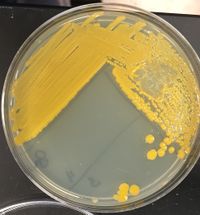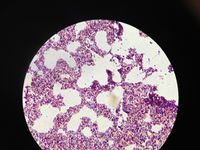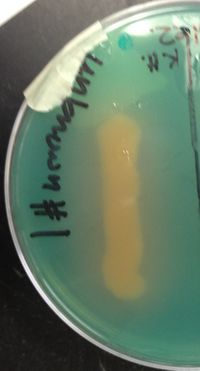Template talk:Genus hollingsworth
Classification
Domain: Bacteria, Phylum: Firmicutes, Class: Bacilli, Order: Bacillales, Family: Bacillales Family XII. Incertae Sedis, Genus: Exiguobacterium, Species: Unknown
Habitat Information
This soil organism was collected in the Hill Country of Fredericksburg, Texas. The soil was very soft and moist, about 5-6" in depth.
Exiguobacterium is found in the Siberian frost1, glaciers in Greenland2, Yellowstone National Park hot springs2 and various other locations of extreme temperatures and conditions2.
Description and Significance
Our observation of Exiguobacteria is that they are small, irregular rod-shaped bacteria, or coccobacilli. Stains performed on our organism revealed a positive Gram stain and small capsules. This organism was negative for endospores. In regard to the colonies, our observation was that the colonies are yellow, shiny, round, and umbonate with a smooth, entire margin.
Collins, et al described Exiguobacterium in the following ways, "Cells vary in shape from rods (3.2 x 1.2 pm) in the exponential phase to short, almost coccoid forms (1-4 x 1.1 pm) in the stationary phase (Gee et al., 1980). Both rods and coccoid cells are Gram-positive..."³ They go on to say that, "Surface colonies on PPYG agar (Gee et al., 1980) are 2 to 3 mm in diameter after 3 d at 25 "C,low convex, orange, opaque, butyrous and easily emulsified...Orange pigment does not diffuse into medium; pigment production does not occur anaerobically."³ While we did not originally note that the colonies are opaque and butyrous and that the colony pigment did not diffuse into any of the mediums used when conducting tests on Exiguobacteria, we are in agreement with Collins, et al on these points.
There are at least 14 species of Exiguobacterium, and they bear hope for bioremediation of a number of pollutants as well as promotion of growth in plants.&sup4; There is some evidence of this organism eating plastic! &sup5;
Genome Structure
Describe the size and content of the genome. How many chromosomes? Circular or linear? Other interesting features? What is known about its sequence? Include S Ribosomal sequence that you obtained from PCR and sequencing here.
One study found the genome size of the tested species of Exiguobacterium to range from 2380.0-2729.6 kb. Exiguobacterium sibiricum 255-15 has a 3.0 Mbp chromosome and two small plasmids, 4.9 and 1.81 Kbp respectively. The plasmid content of most other species and strains of Exiguobacterium is unknown.²
16S rRNA genome:
GCACGCCGCGTGAGTGATGAAGGTTTTCNGANNGTAAAACTCTGTTGTAAGGGAAGAACACGTACGAGAGGAAATGCTCGTACCTTGACGGTACCTTACGAGAAAGCCACGGCTAACTACGTGCCAGCAGCCGCGGTAATACGTAGGTGGCAAGCGTTGTCCGGAATTATTGGGCGTAAAGCGCGCGCAGGCGGCCTTTTAAGTCTGATGTGAAAGCCCCCGGCTCAACCGGGGAGGGCCATTGGAAACTGGAAGGCTTGAGTACAGAAGAGAAGAGTGGAATTCCACGTGTAGCGGTGAAATGCGTAGAGATGTGGAGGAACACCAGTGGCGAAGGCGACTCTTTGGTCTGTAACTGACGCTGAGGCGCGAAAGCGTGGGGAGCAAACAGGATTANATACCCTGGTAGTCCACGCCGTAAACGATGAGTGCTAGGTGTTGGGGGGTTTCCGCCCCTCAGTGCTGAAGCTAACGCATNTANGCACTCCGCCTGGNGAGTACGGCCGCAAGGCTNAAACTCNAAGGANTTGACGGGGACCCGCACAATCGGGGGCACGCCGCGTGAGTGATGAAGGTTTTCNGANNGTAAAACTCTGTTGTAAGGGAAGAACACGTACGAGAGGAAATGCTCGTACCTTGACGGTACCTTACGAGAAAGCCACGGCTAACTACGTGCCAGCAGCCGCGGTAATACGTAGGTGGCAAGCGTTGTCCGGAATTATTGGGCGTAAAGCGCGCGCAGGCGGCCTTTTAAGTCTGATGTGAAAGCCCCCGGCTCAACCGGGGAGGGCCATTGGAAACTGGAAGGCTTGAGTACAGAAGAGAAGAGTGGAATTCCACGTGTAGCGGTGAAATGCGTAGAGATGTGGAGGAACACCAGTGGCGAAGGCGACTCTTTGGTCTGTAACTGACGCTGAGGCGCGAAAGCGTGGGGAGCAAACAGGATTANATACCCTGGTAGTCCACGCCGTAAACGATGAGTGCTAGGTGTTGGGGGGTTTCCGCCCCTCAGTGCTGAAGCTAACGCATNTANGCACTCCGCCTGGNGAGTACGGCCGCAAGGCTNAAACTCNAAGGANTTGACGGGGACCCGCACAATCGGGG
Cell Structure, Metabolism and Life Cycle
Interesting features of cell structure; how it gains energy; what important molecules it produces.
Exiguobacteria are facultative anaerobes and fermentative in their metabolism. This organism ferments glucose and mannitol but not sucrose or lactose. Cell structure composed of Peptidoglycan de-amino acid, L-Lysine. This organism is positive for menaquinone MK-7, a form of Vitamin K produced by bacteria in the intestine that is important for blood clotting. Cellular fatty acids include C17;Oi, C15;Oi, C16O.
Physiology and Pathogenesis
Biochemical characteristics, enzymes made, other characteristics that may be used to identify the organism; contributions to environment (if any).
If relevant, how does this organism cause disease? Human, animal, plant hosts? Virulence factors, as well as patient symptoms.
Gelatin Hydrolysis: gelatinase negative (Collins, et al noted the organism to hydrolyze gelatin.¹ )
DNA Hydrolysis: DNase positive
Lipid Hydrolysis: lipase negative
Phenol Red Broth:
Starch Hydrolysis: alpha-amylase positive
Casein Hydrolysis: casease positive
Methyl Red: positive for mixed acids
Voges-Proskauer: negative
Citrate: negative
SIM: sulfur reduction - negative, indole reaction - negative, motility - light, feathery growth which indicates a weak positive
Nitrate Reduction: does not reduce nitrate (Collins, et al noted the organism to reduce nitrate to nitrite.¹ )
Urea Hydrolysis: negative
Triple Sugar Iron: positive glucose and lactose fermentation, does not reduce sulfur (Other tests showed this organism to not ferment lactose. This test is an outlier on this topic.)
Decarboxylation: does not produce decarboxylase
Phenylalanine Deaminase: negative
Oxidase: negative
Eosin Methylene Blue Agar: negative
Hektoen Enteric Agar: negative
MacConkey Agar: negative
Catalase: positive
Blood Agar: gamma hemolysis
Mannitol Salts Agar: growth, weak positive for mannitol fermentation
Phenylethyl Alcohol Agar: growth, confirms that organism is Gram positive
Bacitracin/Optochin Susceptibility: not susceptible to bacitracin or optochin
Bile Esculin: hydrolyzes esculin
6.5% Salt Tolerance: negative
Kirby-Bauer Antimicrobial Susceptibility Tests for disinfectants: strongly susceptible to bleach, lysol, and lavender but only weakly susceptible to tea tree oil
Kirby-Bauer Antimicrobial Susceptibility Tests for antibiotics: strongly susceptible to ampicillin, linezolid, ticarcillin/clavulanic acid, and ceftazidime
Enzymes cleansed from Exiguobacterium samples are alkaline protease, EKTA catalase, guanosine kinase, ATPases, dehydrogenase, and esterase.²
Exiguobacterium sibiricum may cause human skin infection similar to cutaneous anthrax, and it has been isolated from human skin, wounds, and cerebrospinal fluid.&sup6;
References
1Qiu, Yinghua, Sophia Kathariou, and David M. Lubman. "Proteomic Analysis of Cold Adaptation in a Siberian Permafrost Bacterium – Exiguobacterium Sibiricum 255–15 by Two-dimensional Liquid Separation Coupled with Mass Spectrometry." Proteomics 2006.6 (2006): 5221-233. University of Michigan Library. WILEY-VCH Verlag GmbH & Co. KGaA, Weinheim. Web. 2 Dec. 2015.
2Vishnivetskaya, Tatiana A., Sophia Kathariou, and James Tiedje. "The Exiguobacterium Genus: Biodiversity and Biogeography." Extremophiles 13.May 2009 (2009): 541-55. Web. 1 Dec. 2015. <http://link.springer.com/article/10.1007/s00792-009-0243-5>.
3Collins, M.D., B.M. Lund, J.A.E. Farrow, and K.H. Schleifer. "Chemotaxonomic Study of an Alkalophilic Bacterium, Exiguobacterium Aurantiacum Gen. Nov., Sp. Nov." Journal of General Microbiology 129.7 (1983): 2037-042. Microbiology Society. Microbiology Society. Web. 1 Dec. 2015.
4Ying, Zhang, Shi Ping, and MA Jiong. "Exiguobacterium Spp. and Their Applications in Environmental Remediation." Chinese Journal of Applied & Environmental Biology 2013.05 (2013): 898-904. Web. 1 Dec. 2015.
5Yang, Y., J. Yang, WM Wu, J. Zhao, Y. Song, L. Gao, R. Yang, and L. Jiang. "Biodegradation and Mineralization of Polystyrene by Plastic-Eating Mealworms: Part 2. Role of Gut Microorganisms." Environmental Science and Technology 49.20 (2015): 12087-2093. PubMed.gov. US National Library of Medicine National Institutes of Health. Web. 1 Dec. 2015.
6Tena, Daniel, Nora Mariela Martínez, Josefa Casanova, Juan Luis García, Elena Román, María José Medina, and Juan Antonio Sáez-Nieto. "Possible Exiguobacterium Sibiricum Skin Infection in Human." Emerg. Infect. Dis. Emerging Infectious Diseases 20.12 (2014): 2178-179. PMC. National Center for Biotechnology Information, U.S. National Library of Medicine. Web. 2 Dec. 2015.
Author
Page authored by Danielle St.Romain and Heather McMillion, students of Prof. Kristine Hollingsworth at Austin Community College.





